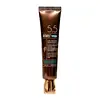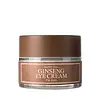What's inside
What's inside
 Key Ingredients
Key Ingredients

 Benefits
Benefits

 Concerns
Concerns

 Ingredients Side-by-side
Ingredients Side-by-side

Water
Skin ConditioningGlycerin
HumectantPropanediol
SolventCyclohexasiloxane
EmollientGlycyrrhiza Glabra Root Water
Antioxidant1,2-Hexanediol
Skin ConditioningNiacinamide
SmoothingDicaprylyl Carbonate
EmollientCetyl Alcohol
EmollientSqualane
EmollientLaminaria Japonica Extract
Skin ProtectingEclipta Prostrata Leaf Extract
Skin ConditioningTheobroma Cacao Seed Extract
AntioxidantFicus Carica Fruit Extract
HumectantCentella Asiatica Extract
CleansingAcmella Oleracea Extract
Skin ProtectingGlycyrrhiza Uralensis Root Extract
Skin ConditioningRubus Fruticosus Fruit Extract
AstringentVaccinium Angustifolium Fruit Extract
Skin ProtectingMalpighia Glabra Fruit Extract
Skin ConditioningHydrogenated Lecithin
EmulsifyingSodium Hyaluronate
HumectantCamellia Sinensis Leaf Water
MaskingBehenyl Alcohol
EmollientPolyglyceryl-2 Stearate
EmulsifyingCetearyl Olivate
Cetearyl Alcohol
EmollientSodium Stearoyl Glutamate
CleansingGlyceryl Stearate
EmollientSorbitan Olivate
EmulsifyingStearyl Alcohol
EmollientDipropylene Glycol
HumectantArginine
MaskingAcrylates/C10-30 Alkyl Acrylate Crosspolymer
Emulsion StabilisingButylene Glycol
HumectantGlyceryl Stearate Se
EmulsifyingAmmonium Acryloyldimethyltaurate/Vp Copolymer
Cholesterol
EmollientDextrin
AbsorbentXanthan Gum
EmulsifyingAdenosine
Skin ConditioningFructooligosaccharides
HumectantCeramide NP
Skin ConditioningBeta-Glucan
Skin ConditioningDisodium EDTA
Caffeine
Skin ConditioningPanthenol
Skin ConditioningHydrolyzed Hyaluronic Acid
HumectantRaffinose
Skin ConditioningFolic Acid
Skin ConditioningTocopherol
AntioxidantTromethamine
BufferingBifida Ferment Lysate
Skin ConditioningGlutathione
Palmitoyl Pentapeptide-4
Skin ConditioningAcetyl Hexapeptide-8
HumectantEthylhexylglycerin
Skin ConditioningCaprylyl Glycol
EmollientWater, Glycerin, Propanediol, Cyclohexasiloxane, Glycyrrhiza Glabra Root Water, 1,2-Hexanediol, Niacinamide, Dicaprylyl Carbonate, Cetyl Alcohol, Squalane, Laminaria Japonica Extract, Eclipta Prostrata Leaf Extract, Theobroma Cacao Seed Extract, Ficus Carica Fruit Extract, Centella Asiatica Extract, Acmella Oleracea Extract, Glycyrrhiza Uralensis Root Extract, Rubus Fruticosus Fruit Extract, Vaccinium Angustifolium Fruit Extract, Malpighia Glabra Fruit Extract, Hydrogenated Lecithin, Sodium Hyaluronate, Camellia Sinensis Leaf Water, Behenyl Alcohol, Polyglyceryl-2 Stearate, Cetearyl Olivate, Cetearyl Alcohol, Sodium Stearoyl Glutamate, Glyceryl Stearate, Sorbitan Olivate, Stearyl Alcohol, Dipropylene Glycol, Arginine, Acrylates/C10-30 Alkyl Acrylate Crosspolymer, Butylene Glycol, Glyceryl Stearate Se, Ammonium Acryloyldimethyltaurate/Vp Copolymer, Cholesterol, Dextrin, Xanthan Gum, Adenosine, Fructooligosaccharides, Ceramide NP, Beta-Glucan, Disodium EDTA, Caffeine, Panthenol, Hydrolyzed Hyaluronic Acid, Raffinose, Folic Acid, Tocopherol, Tromethamine, Bifida Ferment Lysate, Glutathione, Palmitoyl Pentapeptide-4, Acetyl Hexapeptide-8, Ethylhexylglycerin, Caprylyl Glycol
Water
Skin ConditioningButylene Glycol
HumectantCaprylic/Capric Triglyceride
MaskingGlycerin
HumectantPanax Ginseng Root Extract
EmollientCetearyl Olivate
Simmondsia Chinensis Seed Oil
EmollientButyrospermum Parkii Butter
Skin ConditioningCetearyl Alcohol
EmollientSorbitan Olivate
EmulsifyingBeeswax
Emulsion StabilisingMethylpropanediol
SolventHydroxyethyl Acrylate/Sodium Acryloyldimethyl Taurate Copolymer
Emulsion StabilisingIsododecane
EmollientBetaine
HumectantHexanediol
SolventDimethicone
EmollientDimethicone/Vinyl Dimethicone Crosspolymer
Skin ConditioningGlyceryl Caprylate
EmollientSoluble Collagen
HumectantDipotassium Glycyrrhizate
HumectantAllantoin
Skin ConditioningAdenosine
Skin ConditioningDisodium EDTA
Pulsatilla Koreana Extract
Skin ConditioningZanthoxylum Piperitum Fruit Extract
Skin ConditioningEthylhexylglycerin
Skin ConditioningSorbitan Isostearate
EmulsifyingSqualane
EmollientSodium Acetylated Hyaluronate
HumectantHydrolyzed Hyaluronic Acid
HumectantBoswellia Serrata Resin Extract
SmoothingWater, Butylene Glycol, Caprylic/Capric Triglyceride, Glycerin, Panax Ginseng Root Extract, Cetearyl Olivate, Simmondsia Chinensis Seed Oil, Butyrospermum Parkii Butter, Cetearyl Alcohol, Sorbitan Olivate, Beeswax, Methylpropanediol, Hydroxyethyl Acrylate/Sodium Acryloyldimethyl Taurate Copolymer, Isododecane, Betaine, Hexanediol, Dimethicone, Dimethicone/Vinyl Dimethicone Crosspolymer, Glyceryl Caprylate, Soluble Collagen, Dipotassium Glycyrrhizate, Allantoin, Adenosine, Disodium EDTA, Pulsatilla Koreana Extract, Zanthoxylum Piperitum Fruit Extract, Ethylhexylglycerin, Sorbitan Isostearate, Squalane, Sodium Acetylated Hyaluronate, Hydrolyzed Hyaluronic Acid, Boswellia Serrata Resin Extract
 Reviews
Reviews

Ingredients Explained
These ingredients are found in both products.
Ingredients higher up in an ingredient list are typically present in a larger amount.
Adenosine is in every living organism. It is one of four components in nucleic acids that helps store our DNA.
Adenosine has many benefits when used. These benefits include hydrating the skin, smoothing skin, and reducing wrinkles. Once applied, adenosine increases collagen production. It also helps with improving firmness and tissue repair.
Studies have found adenosine may also help with wound healing.
In skincare products, Adenosine is usually derived from yeast.
Learn more about AdenosineButylene Glycol (or BG) is used within cosmetic products for a few different reasons:
Overall, Butylene Glycol is a safe and well-rounded ingredient that works well with other ingredients.
Though this ingredient works well with most skin types, some people with sensitive skin may experience a reaction such as allergic rashes, closed comedones, or itchiness.
Learn more about Butylene GlycolCetearyl alcohol is a mixture of two fatty alcohols: cetyl alcohol and stearyl alcohol. It is mainly used as an emulsifier. Emulsifiers help prevent the separation of oils and products. Due to its composition, it can also be used to thicken a product or help create foam.
Cetearyl alcohol is an emollient. Emollients help soothe and hydrate the skin by trapping moisture.
Studies show Cetearyl alcohol is non-toxic and non-irritating. The FDA allows products labeled "alcohol-free" to have fatty alcohols.
This ingredient is usually derived from plant oils such as palm, vegetable, or coconut oils. There is debate on whether this ingredient will cause acne.
Due to the fatty acid base, this ingredient may not be Malassezia folliculitis safe.
Learn more about Cetearyl AlcoholCetearyl Olivate is an emulsifier and texture enhancer. It is derived from the fatty acids of olive oil and Cetearyl alcohol, and is biodegradable.
As an emulsifier, it is used to prevent oils and waters from separating. It can also
Manufacturers use the name Olivem 1000. This ingredient has been found to preserve the natural microbiome of skin. Having a healthy microbiome helps keep our skin healthy and protects against harmful bacteria. This ingredient is grouped with Sorbitan Olivate under the name Olivem 1000.
Learn more about Cetearyl OlivateDisodium EDTA plays a role in making products more stable by aiding other preservatives.
It is a chelating agent, meaning it neutralizes metal ions that may be found in a product.
Disodium EDTA is a salt of edetic acid and is found to be safe in cosmetic ingredients.
Learn more about Disodium EDTAEthylhexylglycerin (we can't pronounce this either) is commonly used as a preservative and skin softener. It is derived from glyceryl.
You might see Ethylhexylglycerin often paired with other preservatives such as phenoxyethanol. Ethylhexylglycerin has been found to increase the effectiveness of these other preservatives.
Glycerin is already naturally found in your skin. It helps moisturize and protect your skin.
A study from 2016 found glycerin to be more effective as a humectant than AHAs and hyaluronic acid.
As a humectant, it helps the skin stay hydrated by pulling moisture to your skin. The low molecular weight of glycerin allows it to pull moisture into the deeper layers of your skin.
Hydrated skin improves your skin barrier; Your skin barrier helps protect against irritants and bacteria.
Glycerin has also been found to have antimicrobial and antiviral properties. Due to these properties, glycerin is often used in wound and burn treatments.
In cosmetics, glycerin is usually derived from plants such as soybean or palm. However, it can also be sourced from animals, such as tallow or animal fat.
This ingredient is organic, colorless, odorless, and non-toxic.
Glycerin is the name for this ingredient in American English. British English uses Glycerol/Glycerine.
Learn more about GlycerinHydrolyzed Hyaluronic Acid is a form of hyaluronic acid. It is created by the hydrolysis of hyaluronic acid with a high molecular weight. Once created, Hydrolyzed Hyaluronic Acid has a low molecular weight.
Low molecular weight HA has been shown to hydrate and increase elasticity of the skin. Increasing elasticity is also associated with reduction of wrinkle depth.
One study found topical low molecular weight hyaluronic acid may be considered for the treatment of rosacea in the adult population. However, we always recommend speaking with a professional about your skin concerns.
Hyaluronic acids are a humectant. This means they draw moisture from the air. Hyaluronic acids help moisturize, soothe, and protect the skin.
Read more about other common forms of hyaluronic acid:
Learn more about Hydrolyzed Hyaluronic AcidSorbitan Olivate is created from the fatty acids in olive oil and sorbitol.
This ingredient is an oil in water emulsifier. It helps stabilize a product by preventing oils and waters from separating. Sorbitan Olivate also helps hydrate the skin.
Manufacturers sell sorbitan olivate under the name OliveM 1000. OliveM 1000 a multifunctional ingredient. It is self-emulsifying. According to a manufacturer, OliveM 1000 does not disrupt natural skin biome.
Due to its olive oil base, this ingredient may not be fungal-acne safe.
Learn more about Sorbitan OlivateSqualane is an emollient that helps the skin hold onto moisture. It's an oily liquid that occurs naturally in certain types of fish and plant oils.
Because squalane boosts hydration in the skin, it also comes with plenty of benefits: it is an antioxidant and can help fight free radicals and skin damage. Squalane is also found to have a detoxifying effect when applied.
Squalane comes from squalene, which occurs naturally within the sebum of our skin. It is one of the oils our skin produces to keep itself hydrated. Squalane is the hydrogenated version of squalene and has a longer shelf life.
Research shows that squalane is non-irritating (even at 100% concentration).
In general, it's a fantastic ingredient. It does a great job at hydrating the skin, and it's suitable for those with sensitive skin.
The source of squalane may impact malassezia / fungal acne. This is because olive oil derived squalane can contain impurities such as fatty acids and plant waxes. Sugarcane derived squalane is recommended for anyone with malassezia concerns.
Is squalane vegan?
This depends on the source. Squalane can be derived from both plants and animals. Most squalane used in skincare comes from plants.
Please note: the source of squalane is only known if disclosed by the brand. We recommend reaching out to the brand if you have any questions about their squalane.
Read more about squalene with an "e".
Is squalane an oil?
Squalane is often called an oil, but it’s technically not; it’s a hydrocarbon, meaning it’s only made of carbon and hydrogen, unlike true oils which are triglycerides made of fatty acids and glycerol.
The term “oil-free” isn’t regulated, so companies can define it however they want. Some exclude all oils, while others just avoid mineral oil or comedogenic oils.
While some people avoid oils thinking they cause breakouts, the right kind of oil (or oil-like ingredient like squalane) can actually help balance and hydrate your skin. It’s worth testing out simple oils or squalane to see what works best for your skin.
Learn more about SqualaneWater. It's the most common cosmetic ingredient of all. You'll usually see it at the top of ingredient lists, meaning that it makes up the largest part of the product.
So why is it so popular? Water most often acts as a solvent - this means that it helps dissolve other ingredients into the formulation.
You'll also recognize water as that liquid we all need to stay alive. If you see this, drink a glass of water. Stay hydrated!
Learn more about Water